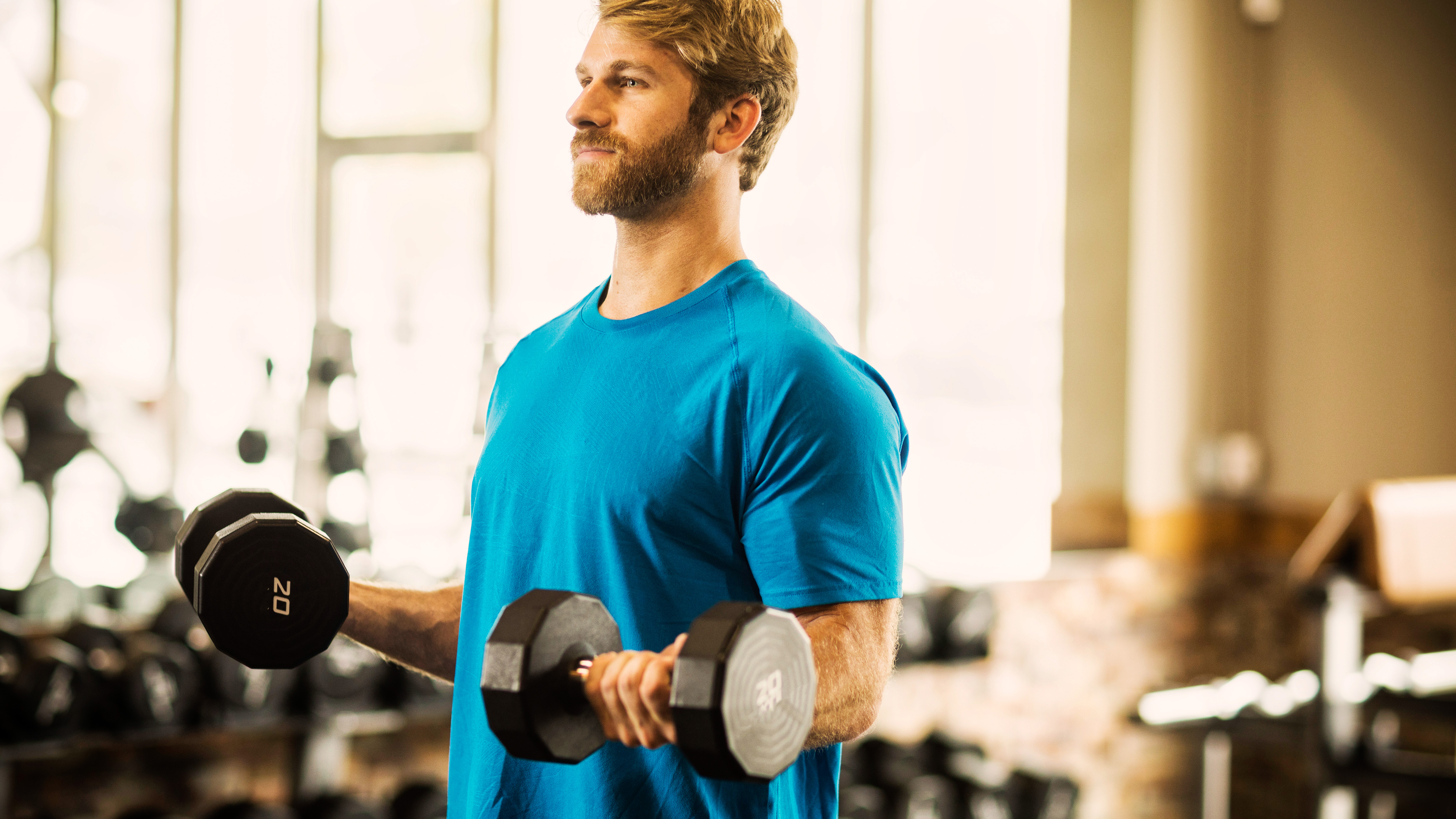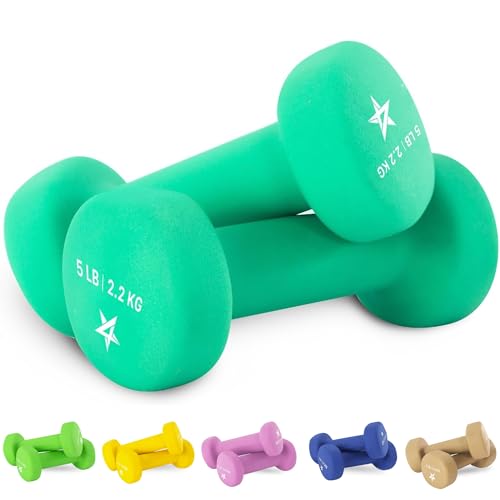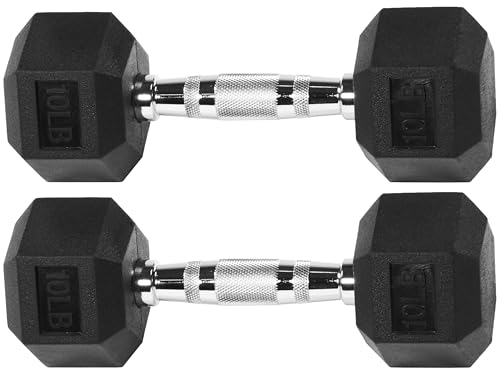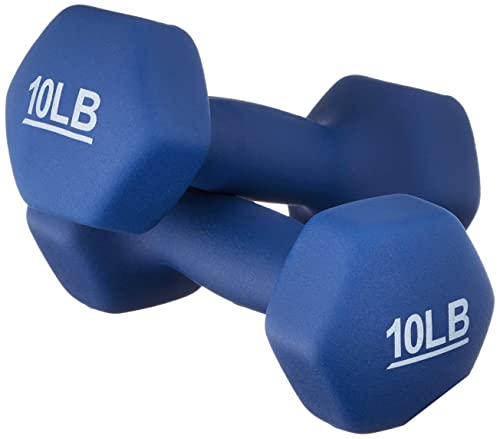A trainer says this is the best workout you can do if you only have two dumbbells
Build strength at home with this trainer’s quick dumbbell workout


If you have a set of lightweight, dusty dumbbells hiding in the corner of your garage or bedroom, it’s time you finally put them to good use.
"If you only have one pair of light to moderate dumbbells, the best workout format is going to be something higher-intensity, or focused on muscular endurance by doing high-rep sets," says ACE-certified PT Pioneer trainer Amanda Capritto.
She's put together this 20-minute AMRAP workout—a routine that challenges you to complete "as many reps and rounds as possible" of a circuit of exercises in a set amount of time. This format encourages you to work hard to get the reps in, challenging your muscles to build strength and endurance.
How to do Amanda Capritto’s dumbbell workout
- Dumbbell squat x10
- Dumbbell overhead press x10
- Dumbbell deadlift x10
- Dumbbell bent-over row x10
- Dumbbell lunge x5 on each leg
- Double biceps curl x10
Start a 20-minute timer then work through the exercises above as a circuit. Once you’ve completed all six moves, return to the beginning and start again. The aim is to complete as many rounds as possible before the clock hits zero.
"Though the goal is to complete as many rounds as you can in 20 minutes, it’s important not to neglect good technique for speed," Capritto adds. "Stay focused on your form, even if it means moving a bit slower. Rest as needed between sets."
This format auto-adjusts to suit all fitness levels. Experienced exercisers will be able to move through the circuit faster, while those newer to strength training can take things at a steadier pace. Both camps should finish the session breathing hard with their muscles burning—the only prerequisite of a successful AMRAP workout is that you push yourself.
Light dumbells
You don't need particularly heavy weights for this routine, as it's a fast-paced workout. Here are a few options available currently on Amazon.
Start your week with achievable workout ideas, health tips and wellbeing advice in your inbox.
1. Dumbbell squat
Reps: 10
- Stand upright with your feet about hip-width apart and a dumbbell in each hand, held at your shoulders.
- Keeping your chest up and back flat, bend your knees to lower your hips as far as you comfortably can towards the floor.
- Drive through your feet to return to the starting position.
2. Dumbbell overhead press
Reps: 10
- Stand upright or sit on a chair with a dumbbell in each hand held at your shoulders.
- Keeping your torso upright, drive the dumbbells directly overhead until your arms are fully extended. Your biceps should finish by your ears.
- Control the dumbbells back to your shoulders and repeat.
3. Dumbbell deadlift
- Stand with your feet hip-width apart with a dumbbell in each hand, arms by your sides.
- Keeping your back flat, hinge at the hips to lower the dumbbells towards the floor, bending your knees slightly and feeling a stretch in the hamstrings.
- Touch the lower head of the dumbbell on the ground, then squeeze your glutes to drive your hips forward and reverse this motion to return to the starting position.
4. Dumbbell bent-over row
Reps: 10
- Stand upright with a dumbbell in each hand.
- Keeping your back flat, hinge at the hips to bend over until your torso is almost parallel with the floor. Allow your arms to hang down.
- Set your shoulder blades back and down. This is your starting position.
- Drive your elbows upward to row both dumbbells to either side of your belly button.
- Pause for a second at the top of the rep, then control the weights back to the starting position.
5. Dumbbell lunge
Reps: 5 on each leg
- Stand upright with a dumbbell in each hand, arms at your sides.
- Keeping your torso upright, step forward with your right leg and lower your left knee until it’s just above the ground. Both knees should form rough right angles.
- Drive through your right foot to return to the starting position. Alternate the leg that steps forward with each repetition.
6. Double biceps curl
Reps: 10
- Stand upright with a dumbbell in each hand, arms at your side and palms facing forward.
- Curl both dumbbells simultaneously up as far as you can towards your shoulders.
- Pause at the top of the rep and squeeze your biceps, then control the dumbbells back to the starting position.
Benefits of this workout
This workout is quick, straightforward and uses minimal equipment, helping you squeeze some mood-boosting movement into even the busiest of days.
"It trains all of the major functional movement patterns; squat, hinge, press, pull and lunge," says Capritto. This is a top way to train if you want carry-over to everyday activities(—daily acts like lunging down to tie up your shoelace or grabbing something from the top shelf at a supermarket will feel easy when you’re used to doing them with dumbbells.
"It’s a full-body workout that engages all of the major muscle groups and promotes all of the standard benefits of weight training," Capritto adds. "These are building strength, muscle growth, prevention of bone density loss and a healthier all-around musculoskeletal system.
"The workout also offers a cardiovascular stimulus, which is helpful for improving endurance, stamina and the health of the cardiorespiratory and cardiovascular systems."
Can you build muscle training at home?
It is possible to build muscle while exercising at home with minimal equipment, Capritto says. However, you need to train in a certain way to hit the stimuli needed to see results.
"Building muscle requires working a muscle to very high intensities," she says. "The most efficient way to accomplish this is by using heavy weights, but you can also perform more reps at lower weights, which is less efficient but doable."
She says beginners in particular can benefit from the latter approach as it allows them to train with minimal equipment, and being new to training means they will probably see faster results at first.
"If you’re just starting out, you don’t need to worry too much about using heavy weights, because your body will adapt to the new stimuli regardless. After several months to a year of weight training, you will likely notice that your muscle growth has stalled.
"You’ll need to increase the weights you use or otherwise introduce a new muscle-building stimulus to your workout plan, such as more reps or power-based movement. You also need to focus on eating enough protein and calories to drive muscle growth."

Harry Bullmore is a Fitness Writer for Fit&Well and its sister site Coach, covering accessible home workouts, strength training session, and yoga routines. He joined the team from Hearst, where he reviewed products for Men's Health, Women's Health, and Runner's World. He is passionate about the physical and mental benefits of exercise, and splits his time between weightlifting, CrossFit, and gymnastics, which he does to build strength, boost his wellbeing, and have fun.
Harry is a NCTJ-qualified journalist, and has written for Vice, Learning Disability Today, and The Argus, where he was a crime, politics, and sports reporter for several UK regional and national newspapers.


